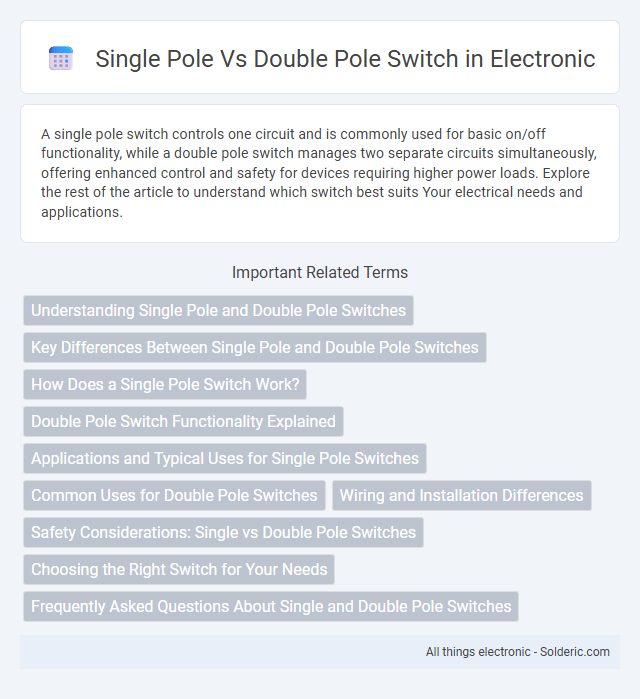A single pole switch controls one circuit and is commonly used for basic on/off functionality, while a double pole switch manages two separate circuits simultaneously, offering enhanced control and safety for devices requiring higher power loads. Explore the rest of the article to understand which switch best suits Your electrical needs and applications.
Comparison Table
| Feature | Single Pole Switch | Double Pole Switch |
|---|---|---|
| Number of Circuits Controlled | One | Two |
| Number of Terminals | Two or Three (Including Ground) | Four or Five (Including Ground) |
| Voltage Rating | 120V typical | 240V typical |
| Usage | Lighting, simple on/off control | Control of 240V appliances, heaters, or large loads |
| Switching Action | Interrupts single live line | Interrupts two live lines simultaneously |
| Safety | Basic isolation on one circuit | Complete isolation on both circuits |
Understanding Single Pole and Double Pole Switches
Single pole switches control one circuit with a single input and output terminal, making them ideal for simple on/off functions. Double pole switches handle two separate circuits simultaneously, providing a safer and more efficient option for controlling higher voltage appliances or multiple devices. Understanding the difference helps you select the right switch for your electrical needs, ensuring both safety and functionality.
Key Differences Between Single Pole and Double Pole Switches
Single pole switches control a single circuit by interrupting one wire, typically the live wire, making them suitable for simple on/off functions in lighting and appliances. Double pole switches manage two separate circuits simultaneously by interrupting both the live and neutral wires, providing safety and control for higher voltage or heavier electrical loads. Key differences include the number of poles controlled, voltage rating, and application complexity, with double pole switches commonly used for 240V devices and single pole switches for standard 120V circuits.
How Does a Single Pole Switch Work?
A single pole switch operates by interrupting or completing the electrical circuit on one live wire, controlling a single light or device from one location. It features two terminals: one for the incoming power and one for the outgoing load, allowing current to flow only when the switch is turned on. This simple on/off mechanism makes single pole switches ideal for basic lighting control in residential wiring systems.
Double Pole Switch Functionality Explained
A double pole switch controls two separate circuits simultaneously, making it ideal for appliances requiring a higher voltage or safety isolation. It disconnects both live and neutral wires, enhancing electrical safety and preventing current flow when switched off. Understanding this functionality helps you choose the correct switch for complex electrical setups and ensures compliance with safety standards.
Applications and Typical Uses for Single Pole Switches
Single pole switches are commonly used for basic on/off lighting control in residential and commercial settings, suitable for single fixtures or outlets. These switches efficiently manage simple circuits where only one line is controlled, making them ideal for bedrooms, living rooms, and kitchens. They are also frequently employed in appliances and devices requiring straightforward power switching without complex wiring.
Common Uses for Double Pole Switches
Double pole switches are commonly used in applications that require controlling 240-volt appliances or devices, such as electric water heaters, dryers, and HVAC systems. These switches provide simultaneous disconnection of both hot wires, enhancing safety and compliance with electrical codes for high-voltage equipment. Your choice of a double pole switch ensures reliable and secure operation in circuits demanding higher power capacity.
Wiring and Installation Differences
Single pole switches control one circuit and use two terminals for simple on/off wiring, making installation straightforward for basic lighting or outlets. Double pole switches manage two circuits simultaneously with four terminals, requiring more complex wiring suited for controlling 240V appliances or heavy-duty equipment. Understanding these wiring and installation differences ensures you select the right switch to match your electrical system's voltage and load requirements.
Safety Considerations: Single vs Double Pole Switches
Double pole switches enhance electrical safety by simultaneously disconnecting both live and neutral wires, reducing the risk of electric shock and short circuits. Single pole switches control only the live wire, which may leave the neutral connection active and pose greater hazards during maintenance or faults. For critical applications and higher voltage circuits, double pole switches offer superior protection by ensuring full circuit isolation.
Choosing the Right Switch for Your Needs
Selecting the right switch depends on your electrical load and safety requirements, with single pole switches typically used for controlling one circuit from a single location, ideal for standard lighting or outlet control. Double pole switches manage two circuits simultaneously, often required for higher voltage appliances like water heaters or HVAC systems, offering enhanced safety by isolating both live wires. Understanding the voltage rating, amperage, and application ensures appropriate switch selection to prevent electrical hazards and optimize functionality.
Frequently Asked Questions About Single and Double Pole Switches
Single pole switches control one circuit and are commonly used for simple on/off functionalities, while double pole switches manage two circuits simultaneously, often for higher voltage appliances. Frequently asked questions include differences in wiring, voltage capacity, and typical applications, with single pole switches suitable for 120V circuits and double pole switches designed for 240V systems. Users also inquire about installation complexity and safety, where double pole switches require careful handling due to their ability to disconnect both live wires.
Single pole vs Double pole switch Infographic

 solderic.com
solderic.com